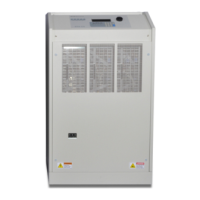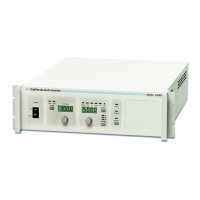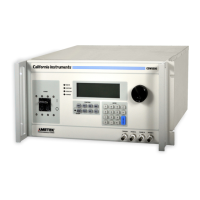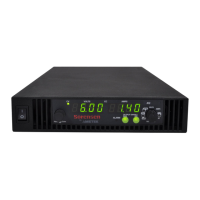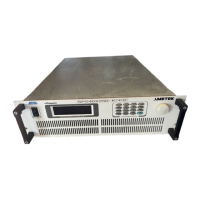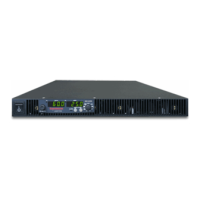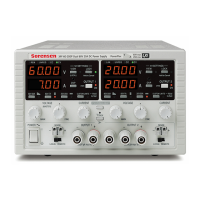User Manual AMETEK Programmable Power
RS Series 154
6.5 Non-Routine Calibration
The non-routine calibration may involve removing the front or top cover of the power source.
Use extreme caution when performing any of these tasks while the system is connected to AC
mains and/or powered up.
6.5.1 Power Source Gain Adjustment
For any RS configuration that requires two or more amplifiers to be operated in parallel for
increased current output, the amplifier gains have to matched as closely as possible to ensure
equal current sharing. If an unbalance exists between amplifier outputs, one or the other
amplifier will deliver more current and may run into its current limit protection before full output
power can be attained.
This procedure details the gain adjustment. Generally, RS units are shipped with the gains
already set correctly so this task should only be undertaken if an amplifier has been replaced or
if two RS units are to be combined that were not originally shipped from the factory as such.
To make this adjustment the front cover must first be removed in order to get access to the
power module output terminals.
If the power system to be adjusted is an RS180 through RS540, the procedure involves
matching the output voltage of the A, B and C power modules in the master cabinet to the A, B
and C power modules in the auxiliary cabinet(s). Proceed as follows:
1. Shut off all power to the cabinets. Disconnect the two wires going to Terminal 6 and
Terminal 7 on the lower front of the power modules. Do this to module A, A’, B, B’, C and C’
in the auxiliary cabinet(s) only. Place some temporary insulation over the lug ends.
2. Connect a DMM between terminals 6 and 7 on the A module in the master cabinet. Power
up the cabinet. Set the controller to the 300V range, program 230V at 60Hz. Enable the
output by pressing the OUTPUT ON/OFF key. Measure the A module output voltage and
write it down. Press the OUTPUT ON/OFF key to disable the output.
3. Move DMM leads to the B module terminals 6 and 7. Press the OUTPUT ON/OFF key to
enable the output. Measure the B module output and write it down, Press the OUTPUT
ON/OFF key to disable the output.
4. Move DMM leads to the C module terminals 6 and 7. Press the OUTPUT ON/OFF key to
enable the output. Measure the C module output and write it down, Press the OUTPUT
ON/OFF key to disable the output.
5. Move the DMM leads to the A module terminals 6 and 7 in the auxiliary cabinet. Press the
OUTPUT ON/OFF key again to enable the output. Verify the phase A module output is
within 50mVolts of the A module in the master cabinet. If it is not, adjust the pot behind the
hole in the upper left corner of the module so the A output matches the A master output
within 50mVolts. Repeat for the A’ module. Press the OUTPUT ON/OFF key to disable the
output.
6. Move the DMM leads to the B module terminals 6 and 7 in the auxiliary cabinet. Press the
OUTPUT ON/OFF key again to enable the output. Verify the phase B module output is
within 50mVolts of the B module in the master cabinet. If it is not, adjust the pot behind the
hole in the upper left corner of the module so the B output matches the B master output
within 50mVolts. Repeat for the B’ module. Press the OUTPUT ON/OFF key to disable the
output.
7. Move the DMM leads to the C module terminals 6 and 7 in the auxiliary cabinet. Press the
OUTPUT ON/OFF key again to enable the output. Verify the phase C module output is
within 50mVolts of the C module in the master cabinet. If it is not, adjust the pot behind the
hole in the upper left corner of the module so the C output matches the C master output
